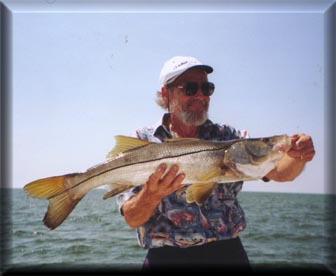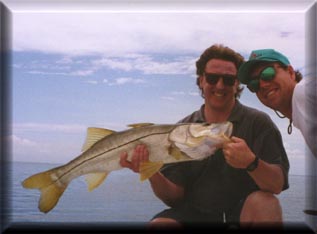Snook Fishing

Florida is one of the places in the United States you can catch the mighty snook. The “striped sergeant” fish is the commanding officer of the flats. They are one of the most sought after gamefish on our saltwater flats fishing charters in the Boca Grande, Clearwater, and St. Petersburg, Florida area. There are a few reasons why.
One of the reasons why many anglers seek these fish and enjoy snook fishing is because they are difficult to catch. They are a challenge to even the most experienced angler. Most people are immediately hooked at their first strike. These fish give you line stripping explosive runs and acrobatical jumps. The snook (also known as the “linsider”) is also one of the best tablefare.

We catch these insiders in shallow water around mangrove trees, docks and the mouths of creeks on our Florida snook fishing charters. They can be caught year round, but the best time is February through November.
The snook will eat artificial baits such as top water plugs, crank baits and jigs, but the bait of choice is always live greenbacks. For those who enjoy the ultimate artificial challenge, uou can also catch them on fly rod.

Information on Snook
Biologist list a dozen snook species worldwide but the most common snook would be centropomus undecimalis is the most abundant and most popular for anglers. The world IGFA record for common snook was caught out of Prismina River on the East coast of Costa Rica weighing 53 pound, 10 ounces and was 54 inches long. The all tackle world record weighed 57 pounds, 12 ounces caught from Rio Naranjo on the Pacific Coast of Costa Rica. This record snook is a black snook, which are larger but are more difficult to catch.
The fever of snook fishing has become extremely intense in Florida. Catch and release restrictions have greatly increased snook population throughout the state. Inshore gillnetting in Florida has been made illegal, in addition to an increase in baitfish population and a string of consecutive mild winters (Water temperatures below 70 degrees stress the snook and temperatures below 60 degrees snook may not survive.) The result is that snook populations are prosperous and on the up rise. This has inshore flats fishing anglers excited.Snook is defiantly by any standard one of the world premier gamefish.
The swordspine snook, tarpon snook and fat snook are rare and average 6 to 10 pounds, which is considerably smaller than the common snook. Twenty to 30 pound fish are regularly caught in Florida, Mexico and Costa Rica. The common snook record in Florida is 44 pounds, 3 ounces but fish have been reported up to 50 pounds. Snook weighing 60-70 pounds have been documented in South America often seen in fish market, which is not uncommon to display a 5-foot fish for sale.
All snook species have a similar appearance, which is long silvery thick body elongated with a tapered head and a large mouth with no teeth. Snook also have a divided dorsal fin and a very pronounced black lateral live extending from the top of the gill plate behind the head to the caudal fin. Once an angler sees a snook or catches a snook he will always be able to identify the fish there is no other fish that looks like a snook or fights like a snook.

Where to find snook
Florida offers the best snook fishing for inshore flats fishing anglers. The snook can be caught from central Florida and south of. The population has prospered due to the efforts in conservation’s. The best snook fishing occurs along the so called “snook line” which extends from Cape Canaveral on the East coast to Port Richey on the West coast. Snook are abundant on both coasts south of that line including part of the Florida Keys.
Snook spawn in passes and inlets during strong full moon and new moon tide of the spring and early summer. Snook pack in channels and cuts near beaches where the tidal flows support their eggs long enough for the eggs to hatch.
Backcountry fishing is classic for catching snook which sharpen up anglers casting skills. Snook are found around most mangrove shorelines throughout south Florida. Snook will be almost anywhere mangroves grow. Tree lines with strong current pushing into them are preferred. The best mangrove edges have water several feet of water in depth. Such places are natural highways for snook to travel.
E-mail Capt. Mike or call 727-243-8918 today to book your next fishing charter!
